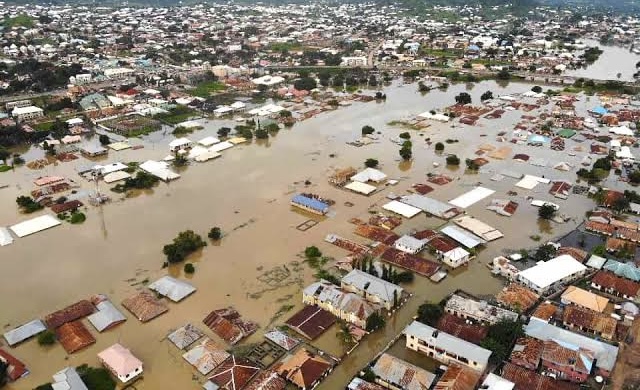The recent catastrophic flooding in Maiduguri, Borno State, has highlighted the region’s vulnerability to natural disasters and the undeniable impact of human negligence and the government’s incompetency.
The scale of destruction, displacement, and death from this catastrophe shows the tragic consequences of inadequate planning, insufficient infrastructure, and the government’s failure to implement long-term strategies to mitigate such disasters.
According to the National Emergency Management Agency (NEMA), the flood began when the Alau Dam spilt after heavy rains, resulting in the city’s worst flooding in 30 years, as the United Nations Human Rights Refugee Council and Maiduguri Metropolitan Council citizens reported.
The Alau Dam is a 112-million-cubic-metre reservoir located in the Konduga LGA. The dam overflowed its banks after heavy rainfall, leading to catastrophic flooding that submerged 70 per cent of Maiduguri’s capital.
According to the NEMA, this disaster resulted in 30 deaths, displaced 414,000 people, and impacted 23,000 households. This tragic outcome could have been avoided if proper maintenance and upgrades had been carried out on the dam, which has a history of collapsing—similar incidents occurred in 1994, affecting several states.
The floods in Maiduguri similar to the ones in Bayelsa and Bauchi States were exacerbated by the government’s failure to heed early warnings from meteorological agencies. Despite these warnings, no substantial actions were taken to protect high-risk areas or evacuate vulnerable populations. Poor urban planning, deforestation, and the lack of effective drainage systems further contributed to the disaster.
Human activities, such as deforestation and unregulated construction, have also intensified the impact of floods across Nigeria. In Maiduguri, the destruction of natural barriers and inadequate infrastructure have left the city defenseless against heavy rainfall. Additionally, the government’s neglect of existing ecological infrastructure has only worsened the situation. Despite receiving N39.6 billion in ecological funds between June 2023 and June 2024, many states, including Borno, failed to invest in strengthening their flood defences or repairing critical infrastructure like dams and drainage systems.
The release of water from Cameroon’s Lagdo Dam, a recurring issue that affects states like Benue, Kogi, and Anambra, has also contributed to this year’s flooding. The government’s failure to negotiate preventive measures with Cameroon and build buffer dams in Nigeria further shows the lack of foresight in addressing flood risks.
The consequences of the floods in Maiduguri have been far-reaching. The collapse of the Alau Dam not only destroyed homes but also compromised social services. Key institutions, such as the Post Office, the State Secretariat, and the University of Maiduguri Teaching Hospital, were submerged. Schools were closed, and basic public services were brought to a halt. In addition to the human tragedy, the floods have caused severe environmental damage. Crocodiles, snakes, and other wildlife were released into communities after escaping from the Shehu Kyarimi Park, putting residents at further risk.
The floods also led to the escape of 200 inmates from the Maiduguri prison, raising security concerns. Moreover, the contamination of water sources poses a significant health risk, particularly with the spread of waterborne diseases. The collapse of the dam has also jeopardised the local harvest, further exacerbating food insecurity in a state already grappling with terrorism, poverty, and instability.
In Bauchi State, flooding has led to significant financial losses, with property damage estimated at N22 billion. Over 52,000 houses were destroyed, and 11,183 livestock were lost. With 24 reported deaths and thousands of injuries, the devastation is widespread. In Yenagoa, torrential rains displaced countless residents and disrupted education as students were stranded, and farmers were forced to harvest prematurely.
Nigeria must overhaul its approach to flood prevention and climate change adaptation. The government’s reliance on reactive, rather than proactive, disaster management has failed. To prevent similar tragedies in the future, several steps must be taken to upgrade and Maintain Existing Infrastructure: The collapse of the Alau Dam should serve as a lesson. Critical infrastructure such as dams, drainage systems, and flood barriers must be regularly inspected, maintained, and upgraded where necessary.
Investing in Early Warning Systems to strengthen meteorological and disaster response agencies like NEMA is also essential. These agencies need modern equipment, training, and resources to monitor rainfall, track potential flood events, and issue timely warnings to affected areas. Early evacuation plans and disaster preparedness training should also be prioritised.
The government must also enforce stricter building codes and prevent construction in flood-prone areas. Natural flood defences such as wetlands and forests should be preserved, while urban areas must incorporate green infrastructure to help manage excess water during heavy rains.
Nigeria’s deforestation rate is among the highest in the world. Planting trees and restoring natural ecosystems can help reduce soil erosion and improve water absorption, mitigating the effects of floods.
Nigeria must engage in stronger negotiations with neighbouring countries, such as Cameroon, to develop a coordinated response to shared water resources like the Lagdo Dam. Building buffer dams in Nigeria is critical to preventing the seasonal flooding caused by water releases from the dam.
The recent floods in Maiduguri and other parts of Nigeria are tragic reminders of the consequences of government inaction, poor planning, and environmental mismanagement. With the right measures in place, such disasters are preventable. The government must shift from its reactive stance to a more proactive approach. Only then can Nigeria hope to prevent future disasters and protect its citizens from the devastating effects of floods.
